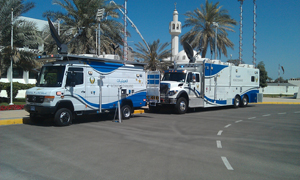|
You need only to look up at the sky at the right time and in the right direction – perhaps helped by a smartphone app – to see for yourself that we’ve come a long way since Sputnik uttered its first lonely bleeps back in 1957, kicking off the multi-billion dollar space race between Russia and the United States. Although estimates of the total number of active satellites now lurking in space varies wildly around the low thousands – especially when the figures for inactive ‘space junk’ are added into the equation – there are currently just over 400 satellites set in geostationary orbits alone, carrying out a host of communication and observation functions. Recent advances in technology, both in the satellites themselves and in the launch platforms, have reduced costs dramatically, bringing them within reach of even small countries. Taking these developments even further, the US defence agency DARPA announced earlier this year that it is beginning talks with mobile phone manufacturers and other industry sectors looking to exploit their technologies to develop cheap – sub-$500?000 – disposable observation satellites for temporary battlefield use that can be easily launched from aeroplanes. From a slightly more alternative perspective comes the hacker community, with its HackerSpace initiative aimed at encouraging the development of ultra-cheap earth stations able to use low Earth orbiting satellites as back-ups in the event of emergencies or of state interference with terrestrial communications. In the meantime, for the TETRA and critical communications community – and especially for those concerned with public safety and emergency service environments – satellite communications have a most important role to play, as has already been well demonstrated in a number of real-life situations. As the performance of devices both in the air and on the ground continues to rapidly improve and organizations seek to do more with less as a result of tightening budgets, the satellite option becomes increasingly important in a number of ways – both strategic and tactical. Ground terminals Peter Clemons, managing director of the newly-formed consultancy Quixoticity and director and a retiring board member of the TETRA + Critical Communications Association, explains the potential of satcoms in the continuing evolution of public safety communications: “There are a number of key strengths of satellite communications – and more specifically Very Small Aperture Terminal (VSAT) operations using geostationary satellites that don’t need to track satellites and only require relatively small dishes. Essentially, their primary role is in providing centralized management of communications in places where terrestrial links are absent, have been destroyed by disasters or where additional forms of back-up and redundancy are required in specific situations. “In terms of actual topologies”, Clemons continues, “it’s possible to use either the more common Earth hub approach where each VSAT on-the-ground unit is interlinked via a central hub, or a direct approach where interconnection is achieved directly through the satellite. On top of this, it’s possible to structure communications in different ways such as point-to-point, broadcast - i.e. multipoint, or interactive where everyone can communicate with everyone else. Speeds available typically range from 56?kbit/s up to 4?Mbit/s. “There are, however, extremely important service quality issues for network designers to consider when satellite links are being deployed. Because of the delays inherent in the signalling and transport paths and the asynchronous nature of the links involved, jitter and packet loss can occur and careful engineering and call discipline is required to cope with these. Some systems on the market, such as Teltronic’s Nebula, for example, are able to cope with these environments.” Threefold advantages “Latency is just one of those perennial issues that can also happen in terrestrial IP-based systems, for example”, comments Bernie Bradfield , general manager at Datasat Communications, an international satellite services and technology provider which is currently working with Airwave (provider of a TETRA-based public safety network in the UK) and L-3 Communications, amongst others. “In practice, in many situations, users hardly notice that satellite is being used for part of the transmission path, but there will be a call set-up delay of around a second and half. “The advantages of using satellites are, however, clear and essentially fall into three elements, typified by the kind of support that we provide to Airwave.
|

 Alun Lewis looks into the use of satellite links in
Alun Lewis looks into the use of satellite links in